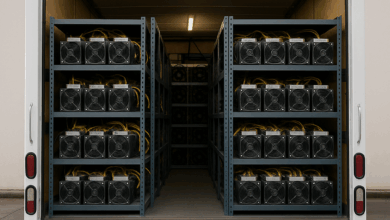AMBCrypto CEO talks about sustainable practices in cryptocurrency mining

Renewable energy elements such as solar panels and wind turbines integrated with digital blockchain nodes symbolize the harmony between innovation and environmental responsibility in cryptocurrency mining.
Himanshu Kumar, CEO of AMBCrypto, outlines strategies for sustainable cryptocurrency mining, with a focus on renewable energy, energy-efficient algorithms, and community-led initiatives. By highlighting innovations such as heat recycling and blockchain transparency, he calls for a balance between growth and environmental stewardship to create a greener future for the cryptocurrency industry.
Environmental impact of cryptocurrency mining
Cryptocurrency mining has drawn significant criticism due to its environmental footprint. With rising energy consumption and increasing oversight by environmental groups, sustainable practices are no longer optional. Himanshu Kumar [https://www.linkedin.com/in/himanshu1332/]CEO of AMBCrypto [https://ambcrypto.com/]addresses the need for environmentally friendly mining solutions that balance innovation and environmental stewardship. He stresses that “the cryptocurrency industry should lead by example in addressing its environmental challenges.”
Mining operations around the world consume huge amounts of energy, compared to electricity use in small countries. This has led to a pressing demand for sustainable solutions to mitigate environmental damage while supporting the rapid growth of blockchain technology.
Transition to renewable energy
Renewable energy sources are reshaping the mining landscape. “Innovative mining companies are harnessing solar, wind and hydroelectric power to reduce carbon emissions,” notes Kumar.
Solar farms in sunny areas and hydroelectric power plants in areas with abundant water resources are becoming popular options for mining facilities. These renewable options not only reduce the industry’s carbon footprint, but also reduce long-term operating costs. “Mining based on renewable energy sources is a profitable solution for the industry and the planet,” Kumar asserts.
Countries such as Iceland and Canada, with their natural geothermal and hydroelectric resources, have emerged as leaders in sustainable mining practices. Kumar points out that these sites demonstrate how renewable energy can make cryptocurrency mining more efficient and environmentally friendly.
The role of energy-efficient algorithms
The shift toward energy-efficient algorithms is another crucial development. Proof of Stake (PoS) and similar consensus mechanisms are gaining traction as alternatives to the energy-intensive Proof of Work (PoW) model. “Ethereum’s move to Proof of Stake (PoS) is a milestone in making cryptocurrency mining more sustainable,” notes Kumar.
PoS technology significantly reduces the power required for network operations, relying on validators rather than miners to maintain the blockchain. Kumar believes that adopting such models across other cryptocurrencies could significantly reduce the overall energy consumption in the industry. “The future of the industry lies in embracing innovation that prioritizes efficiency without compromising security,” he adds.
Geographic shifts in mining
Regions with abundant renewable energy, such as Scandinavia and Canada, are emerging as mining centres. “These areas offer sustainable and cost-effective energy solutions for miners,” Kumar highlights.
The geographic shift in mining operations is driven by the search for low-cost renewable energy sources. Scandinavia’s surplus wind and hydroelectric power, combined with its cold climate, provides an ideal environment for cryptocurrency mining. Likewise, hydroelectric power plants and progressive energy policies in Canada attract large-scale mining operations seeking sustainability.
Kumar stresses the importance of this trend, noting that geographical diversification reduces the risks of centralization while promoting environmentally friendly practices globally.
Heat recycling for a greener future
Innovative practices, such as heat recycling, add to sustainability in mining. Mining operations generate large amounts of heat, which is often wasted. However, forward-thinking companies are reusing this heat for agricultural and industrial uses. “This not only improves energy use, but also shows how mining can contribute to local economies,” says Kumar.
For example, some mining facilities direct excess heat into greenhouses, promoting year-round agriculture in cold regions. Others provide heating for residential or commercial buildings. These initiatives demonstrate how the industry can transform a mining byproduct into a resource, creating shared value for surrounding communities.
Community-led initiatives
Community-led mining initiatives are setting new standards for sustainability and inclusivity. These projects focus on sustainable practices and benefit-sharing models. “Collaboration between communities and miners can redefine the image of the industry,” Kumar adds.
By engaging local stakeholders, these initiatives ensure that mining operations align with community needs and environmental goals. Kumar highlights examples where mining revenues are being reinvested in local infrastructure projects, education and renewable energy. “When a community thrives alongside industry, it creates a more sustainable and ethical mining ecosystem,” he explains.
Leverage technology for monitoring and efficiency
Advanced technologies play a crucial role in making mining more sustainable. AI-based systems monitor energy use and optimize mining operations in real time. “Harnessing data and automation can dramatically improve efficiency, reduce waste, and lower costs,” Kumar asserts.
Blockchain itself offers solutions for transparency in energy use. Kumar suggests that incorporating smart contracts to track and verify renewable energy sources could set new standards of accountability in the industry.
Conclusion: Building a sustainable future
Sustainability in cryptocurrency mining can be achieved with the right strategies. Kumar envisions an industry where innovation and environmental responsibility go hand in hand. “It is time for the cryptocurrency industry to align its practices with global sustainability goals and lead by example,” he concludes.
As mining operations continue to expand, Kumar is calling for industry-wide cooperation to address environmental concerns. “The future of blockchain depends on our ability to create systems that are not only profitable, but also sustainable and fair for all stakeholders.”
Media communication
Company name: AMBCrypto
Contact Person: Sujeev Thomas
Email: Send email [https://www.abnewswire.com/email_contact_us.php?pr=ambcrypto-ceo-on-sustainable-practices-in-crypto-mining]Country: India
Website: https://ambcrypto.com/
This version is published on openPR.
https://cdn.open-pr.com/1/0/103276951_g.jpg




